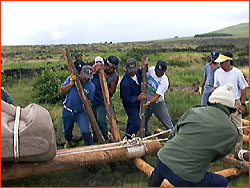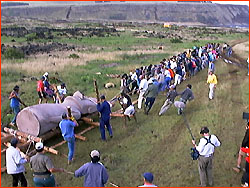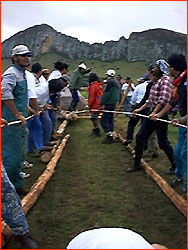
|
 |
 |
 The Moai is Moved
The Moai is Movedby Liesl Clark April 30, 1998 Today a team of 60 Rapa Nui people pulled a replica moai statue almost 100 meters over the muddy, rock-strewn terrain on this island's south coast. We learned two things today. First, we don't need the crew we estimated to do the moving. Second, our estimate of the the weight of the statistically-average moai may be too high, and our replica weighs nearly 10 tons, not 15. "We did it!" exclaimed Jo Anne Van Tilburg, "and I'm sure we can move it uphill or on any terrain." But even as Van Tilburg's team celebrated their preliminary success, the question remains whether this was the actual method the Rapa Nui culture used to move these massive stone figures as recently as 300 years ago.  The moai transport experiments began with an attempt to move
the replica on a sledge with eucalyptus rollers over rails
positioned on the ground. Face up and head first, the concrete
moai was placed by crane between the original moai quarry at
Rano Raraku, and
Tongariki, the largest ahu on Easter Island. With the aid of levers,
the expertly-lashed wooden sledge moved over the rollers a few
feet, but soon the rollers jammed into each other. "We've
proven it slides, it doesn't roll," explained Jan Van Tilburg,
Jo Anne's architect husband. The Van Tilburg team then decided
to lash the rollers to the sledge and slide the whole rig over
the rails. "This represents the transfer of technology from a
traditional Polynesian canoe ladder to transporting a Rapa Nui
moai. Local traditions are well represented here," said Jo
Anne Van Tilburg, who enlightened us on how her team came up
with this method of transporting a small moai the size of a
mini bus. Polynesian canoe-voyaging technology is the crux of
Van Tilburg's theory of moai transport.
The moai transport experiments began with an attempt to move
the replica on a sledge with eucalyptus rollers over rails
positioned on the ground. Face up and head first, the concrete
moai was placed by crane between the original moai quarry at
Rano Raraku, and
Tongariki, the largest ahu on Easter Island. With the aid of levers,
the expertly-lashed wooden sledge moved over the rollers a few
feet, but soon the rollers jammed into each other. "We've
proven it slides, it doesn't roll," explained Jan Van Tilburg,
Jo Anne's architect husband. The Van Tilburg team then decided
to lash the rollers to the sledge and slide the whole rig over
the rails. "This represents the transfer of technology from a
traditional Polynesian canoe ladder to transporting a Rapa Nui
moai. Local traditions are well represented here," said Jo
Anne Van Tilburg, who enlightened us on how her team came up
with this method of transporting a small moai the size of a
mini bus. Polynesian canoe-voyaging technology is the crux of
Van Tilburg's theory of moai transport.
 Urged on by Van Tilburg's team, the 60 Rapa Nui pullers moved
the moai over relatively flat terrain rapidly. The success of
the day was seen as both a victory, but also as an opportunity
to look closely at the archaeological evidence that exists
elsewhere on the island. How many people were actually used to
move a moai of this size? Were the moai transported face up or
face down? What would it have been like to use Jubea
chilensis, the palm logs available on the island to the
original Rapa Nui people? It moved, but is this the method the
ancient Easter Islanders used?
Urged on by Van Tilburg's team, the 60 Rapa Nui pullers moved
the moai over relatively flat terrain rapidly. The success of
the day was seen as both a victory, but also as an opportunity
to look closely at the archaeological evidence that exists
elsewhere on the island. How many people were actually used to
move a moai of this size? Were the moai transported face up or
face down? What would it have been like to use Jubea
chilensis, the palm logs available on the island to the
original Rapa Nui people? It moved, but is this the method the
ancient Easter Islanders used?
Tomorrow the Van Tilburg experiments continue. They will use a crane to reposition the moai face down on the sledge and transport it an estimated 200 meters to a sloping road that leads toward the ahu and pedestal. The ahu has been constructed for the raising experiments, which will begin in two days. The challenge in moving the moai will be greater on a sloping road, and especially difficult on the the uphill ramp that will put the moai at its final resting place before being raised. Lessons Learned (May 11) A New Way to Move a Moai (May 9) Moai is Upright (May 6) Moai Nearly Raised (May 5) A Tourist Attraction (May 3) The Secret of the Sledge (May 2) Moai Ready to be Raised (May 1) The Moai is Moved (April 30) 15-Ton Moai Removed from Mold (April 27) Moai Platform Complete (April 26) Moai Mold is Filled (April 24) Moai Mold Ready for Concrete (April 23) Statue Mold En Route (April 22) The Team Arrives (April 20) Arrival on Rapa Nui (April 17) Photos: Liesl Clark Move a Megalith | Dispatches | Explore the Island | Lost Civilization Resources | E-mail | Table of Contents | Easter Island Home Editor's Picks | Previous Sites | Join Us/E-mail | TV/Web Schedule About NOVA | Teachers | Site Map | Shop | Jobs | Search | To print PBS Online | NOVA Online | WGBH © | Updated November 2000 |